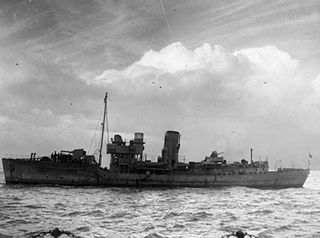HMS Gladiolus was a Flower-class corvette of the Royal Navy, the first ship of her class.
German submarine U-333 was a Type VIIC U-boat of Nazi Germany's Kriegsmarine during World War II. The submarine was laid down on 11 March 1940 at the Nordseewerke yard at Emden, launched on 14 June 1941, and commissioned on 25 August 1941 under the command of Kapitänleutnant Peter-Erich Cremer. After training with the 5th U-boat Flotilla at Kiel, on 1 January 1942 U-333 was transferred to the 3rd U-boat Flotilla based at La Pallice for front-line service.

German submarine U-125 was a Type IXC U-boat of Nazi Germany's Kriegsmarine during World War II. She was laid down at the DeSchiMAG AG Weser as yard number 988 on 10 May 1940, launched on 10 December and commissioned on 3 March 1941. In seven patrols, she sank 17 ships for a total of 82,873 gross register tons (GRT). The boat was a member of three wolfpacks. She was sunk on 6 May 1943. All 54 men on board died.
German submarine U-438 was a Type VIIC U-boat of Nazi Germany's Kriegsmarine during World War II.
Vorwärts was a wolfpack of German U-boats that operated from 25 August to 26 September 1942, in the Battle of the Atlantic during World War II. They attacked several convoys, principally Convoy ON 127, sailing from Liverpool to New York, and sank fifteen ships for a total of 79,331 gross register tons (GRT), and damaged nine (81,141 GRT).
OB 293 was a North Atlantic convoy which ran during the battle of the Atlantic in World War II. It was notable for seeing the loss to the Kriegsmarine (KM) of U-47, with her commander KL Günther Prien, the person responsible for the sinking of HMS Royal Oak two years previously.

HMS Peony was a Flower-class corvette of the Royal Navy. In 1943 she was transferred to the Royal Hellenic Navy as RHNS Sachtouris, serving throughout World War II and the Greek Civil War. She was returned to the Royal Navy in 1951 and scrapped in April 1952.
HMS Arabis was a Flower-class corvette of the Royal Navy. The ship was commissioned into the Royal Navy as HMS Arabis. She was transferred to the United States Navy in 1942, serving as USS Saucy. Returned to the United Kingdom in 1945, she was recommissioned into the Royal Navy as HMS Snapdragon.
Escort Group B7 was a British formation of the Royal Navy which saw action during the Second World War; principally in the Battle of the Atlantic.
Seewolf was the name of three separate wolfpacks of German U-boats that operated during the Battle of the Atlantic in World War II.
HMS Polyanthus was a Flower-class corvette of the Royal Navy. She was launched on 30 November 1940 from Leith Docks on the Firth of Forth, at an estimated cost of £55,000. Polyanthus was sunk by the German submarine U-952 using new German weapons technology on 20 September 1943 about 1,000 miles southwest of Reykjavík during convoy escort duty in the Battle of the North Atlantic.

German submarine U-105 was a Type IXB U-boat of Nazi Germany's Kriegsmarine. She was ordered on 24 May 1938 as part of Germany's naval rearmament program. Her keel was laid down in Bremen on 16 November 1938. After roughly seven months of construction, she was launched on 15 June 1940 and formally commissioned into the Kriegsmarine on 10 September 1940.
German submarine U-568 was a Type VIIC U-boat built for Nazi Germany's Kriegsmarine for service during World War II. She conducted five patrols, sinking one merchant ship, two warships, and severely damaging another warship. On 28 May 1942, she was depth charged and sunk in the Mediterranean Sea; all hands survived.
HMS Gould (K476) was a British Captain-class frigate of the Royal Navy in commission during World War II. Originally constructed as the United States Navy Evarts-class destroyer escort USS Lovering (DE-272), she served in the Royal Navy from 1943 until her sinking in 1944.

Bristol City was a British cargo steamship that was launched in 1919 and sunk in the Battle of the Atlantic in 1943. She was the third of five ships of that name owned by Bristol City Line.

Wentworth was a British cargo steamship that was built in 1919 as War Phlox. The UK Shipping Controller ordered her, and she was built to War Standard design Type A. The Dalgliesh Shipping Company of Newcastle upon Tyne bought her when new, renamed her Wentworth, and owned her throughout her working life. She was sunk in the North Atlantic in 1943 during the Battle of the Atlantic, with the loss of five of her 47 crew.

HMS Alisma was a Flower-class corvette that served in the Royal Navy.

HMS Sunflower was a Flower-class corvette of the Royal Navy. She served during the Second World War.

HMS Periwinkle was a Flower-class corvette, built for the Royal Navy during the Second World War, and was in service in the Battle of the Atlantic. In 1942 she was transferred to the United States Navy as part of the Reverse Lend-Lease arrangement and renamed USS Restless, one of the Temptress-class gunboats. With the end of hostilities she was returned to the Royal Navy and sold into mercantile service.
Convoy RS 3 was a South Atlantic convoy which ran during the height of the Battle of the Atlantic in World War II. It was a small coastal convoy going from Rabat to Sierra Leone. The convoy lost its three biggest ships to U-boat attacks in March 1943, which contributed to the fact that in March 1943 most of the ships sunk by U-boats were lost in convoys. As convoying was the key answer to the U-boat threat, this led to a temporary crisis in Allied shipping.









